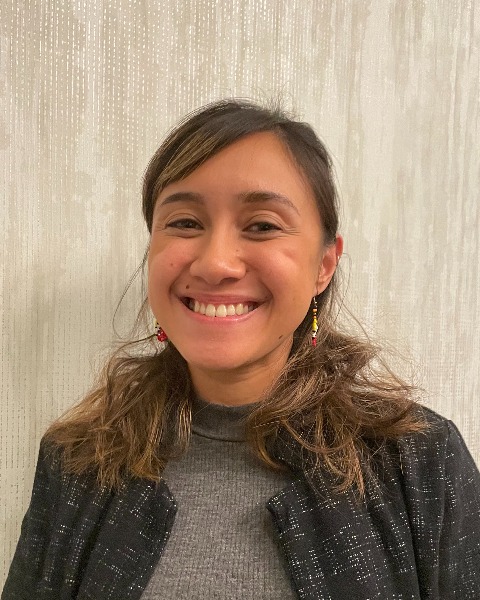Anatomy Education Posters
Poster: Anatomy Education Posters
97 - Encounters of Humanism in the Gross Anatomy Laboratory
Sunday, March 24, 2024
5:00pm - 7:00pm US EDT
Location: Sheraton Hall
Poster Board Number: 97
There are separate poster presentation times for odd and even posters.
Odd poster #s – first hour
Even poster #s – second hour
Co-authors:
There are separate poster presentation times for odd and even posters.
Odd poster #s – first hour
Even poster #s – second hour
Co-authors:
Jessica Byram - Assistant Professor of Anatomy, Cell Biology & Physiology, Anatomy, Cell Biology & Physiology, Indiana University School of Medicine; Elizabeth Agosto - Assistant Professor of Clinical Anatomy, Cell Biology & Physiology, Anatomy, Cell Biology, and Physiology, Indiana University School of Medicine

Brenda K. Anak Ganeng, M.S.
Graduate Student/Associate Instructor
Indiana University School of Medicine
Indianapolis, Indiana, United States
Presenting Author(s)
Abstract Body : Human anatomical dissections provide diverse learning opportunities to students, both in acquiring scientific knowledge of the human body and the formation of nontraditional, discipline-independent skills (NTDIS). Opponents to dissection argue this practice is de-humanizing to the donor and inappropriately introduces students to death However, the NTDIS associated with anatomical dissection include compassionate behaviors like humanistic and empathetic values, all of which are important to foster in future health professionals and may mitigate some of the potentially negative aspects of dissection. This study investigates whether the purposeful integration of humanism in the gross anatomy curriculum helps to mitigate distruptive experiences for learners.
Learners who completed an undergraduate, graduate or health professional gross anatomy course in 2023 at Indiana University School of Medicine were invited to complete a survey. These courses offer varying levels of formal humanism. Learners were asked about aspects of human body dissection they found disruptive to their learning and to describe their experiences in a free response box. The free responses were analyzed using content analysis to find keywords reflecting encounters of humanism in their dissection experiences and comparisons were made by course.
43 of the 70 students who completed the survey identified laboratory sessions with elements disruptive to their learning; sessions involving the pelvis/perineum and head were cited most. Learners described certain procedures in these labs to be violent, dehumanizing, mutilating or disrespectful. Learners described being reminded of donors’ humanity when these disruptive procedures were being conducted. Learners in anatomy courses with more formal curricular focuses on humanism, such as wriiten reflections and patient reports on students’ experiences with dissection, seemed to report less negative experiences when dissecting donors. Out of the 43 responses describing negative experiences, a majority of these learners took courses that had less formal curricular focuses on humanism.
Learners who were provided opportunities in their gross anatomy course to reflect on donors’ humanism seemed less likely to describe negative experiences in the gross anatomy lab. We acknowledge the small sample size and low number of responses in proportion to class size as limitations of our work. Future work will involve follow-up interviews to explore in depth learners’ encounters with humanism in the gross anatomy lab.
This work helps us identify ways to improve the holistic experience of gross anatomy labs for learners, and suggests a greater need for educators to focus on formal curriculum in humanism and publish on the positive effects of this NTDIS.
Learners who completed an undergraduate, graduate or health professional gross anatomy course in 2023 at Indiana University School of Medicine were invited to complete a survey. These courses offer varying levels of formal humanism. Learners were asked about aspects of human body dissection they found disruptive to their learning and to describe their experiences in a free response box. The free responses were analyzed using content analysis to find keywords reflecting encounters of humanism in their dissection experiences and comparisons were made by course.
43 of the 70 students who completed the survey identified laboratory sessions with elements disruptive to their learning; sessions involving the pelvis/perineum and head were cited most. Learners described certain procedures in these labs to be violent, dehumanizing, mutilating or disrespectful. Learners described being reminded of donors’ humanity when these disruptive procedures were being conducted. Learners in anatomy courses with more formal curricular focuses on humanism, such as wriiten reflections and patient reports on students’ experiences with dissection, seemed to report less negative experiences when dissecting donors. Out of the 43 responses describing negative experiences, a majority of these learners took courses that had less formal curricular focuses on humanism.
Learners who were provided opportunities in their gross anatomy course to reflect on donors’ humanism seemed less likely to describe negative experiences in the gross anatomy lab. We acknowledge the small sample size and low number of responses in proportion to class size as limitations of our work. Future work will involve follow-up interviews to explore in depth learners’ encounters with humanism in the gross anatomy lab.
This work helps us identify ways to improve the holistic experience of gross anatomy labs for learners, and suggests a greater need for educators to focus on formal curriculum in humanism and publish on the positive effects of this NTDIS.

